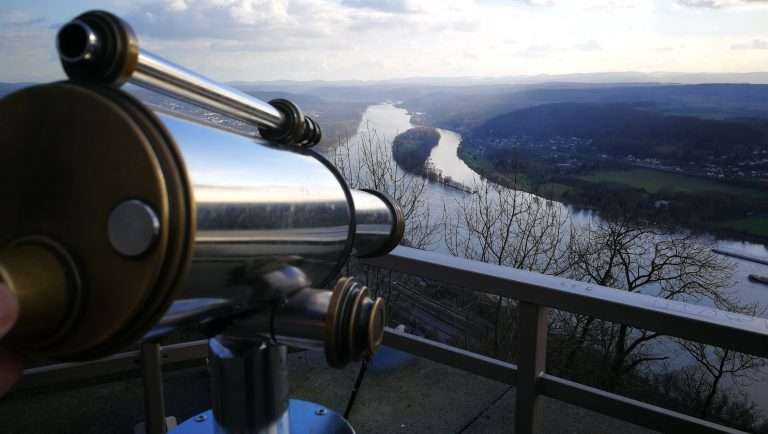
May in Bonn is cold and grey – Le Carré’s ‘A Small Town in Germany’
Apart from the seemingly inevitable local crime novels and a few autobiographical special cases, Bonn hardly ever appears as the setting for a novel. This also applies to its years as the capital city of Germany. Of the few novels that deal with the politics of the ‘Bonn Republic,’ Wolfgang Koeppen’s ‘Das Treibhaus’ (The Greenhouse) alone satisfies the highest literary standards as a roman à clef of the young Federal Republic. Unfortunately, it is hardly known outside Germany.
This means that Bonn makes only one appearance in world literature. It was created by John Le Carré (actually David John Moore Cornwell, 1931-2020) in his novel ‘A Small Town in Germany’, published in 1968. The author of The Spy Who Came in from the Cold and literary father of George Smiley is usually classified as a writer of pulp fiction in Germany. In the English-speaking world, he is rightly regarded as one of the most important authors of the recent past.
 A Small Town in Germany is one of Le Carré’s lesser-known books. This may be because, unlike most of his works from the 1960s and 1970s, it does not revolve around the theme of the Cold War and does not feature the anti-Bond character George Smiley. Instead, the plot is embedded in the domestic politics of the Federal Republic of Germany and is therefore less accessible to an international audience than the global East-West conflict. It is set exclusively in Bonn and its immediate surroundings. Le Carré draws on his own experiences. From 1961 to 1963, he was stationed in Germany by the British Secret Service working undercover as Second Secretary at the British Embassy in Bonn. At that time writing was a part-time endeavour.
A Small Town in Germany is one of Le Carré’s lesser-known books. This may be because, unlike most of his works from the 1960s and 1970s, it does not revolve around the theme of the Cold War and does not feature the anti-Bond character George Smiley. Instead, the plot is embedded in the domestic politics of the Federal Republic of Germany and is therefore less accessible to an international audience than the global East-West conflict. It is set exclusively in Bonn and its immediate surroundings. Le Carré draws on his own experiences. From 1961 to 1963, he was stationed in Germany by the British Secret Service working undercover as Second Secretary at the British Embassy in Bonn. At that time writing was a part-time endeavour.
As Le Carré once remarked elsewhere, the plot takes place in the ‘near future’ from the year the book was published – if you look closely: in May 1970. The political panorama that forms the backdrop is bleak. Le Carré composes it from elements that helped shape the domestic politics of the Federal Republic in the 1960s, adding fictional and exaggerated elements to create an ugly dystopia: the grand coalition is still in power. The opposition FDP is infiltrated by shady figures with roots in the Nazi era. There is a powerful political alliance between the student movement and what we would today call right-wing populists. The target of their hatred is Great Britain. The Bundestag is still debating emergency laws, an amnesty for Nazi criminals comes into force, and accession negotiations between the EEC and Great Britain are going badly in Brussels. The country is on the brink of major unrest.
In this situation, a troubleshooter arrives in Bonn from London. A junior embassy employee has disappeared, apparently gone into hiding. Suspicions of espionage are rife. Alan Turner is tasked with getting to the bottom of the matter. Over the course of several weeks in May, he scrutinises the embassy’s operations, uncovers some of the staff’s dirty secrets and gets closer and closer to the man he is looking for, his character and his motives. This man is, if you will, the real protagonist of the novel. Yet he hardly ever appears in the book – only briefly at the beginning and end. This much can be revealed: it does not end well.
Le Carré’s picture of Bonn is as bleak as the plot. It begins with the weather – although it is May, it is consistently hazy and damp. There is no sign of warmth, and much of the action takes place at night. Le Carré anticipates an atmosphere that J.K. Rowling’s dementors would later spread. The city is cramped and narrow-minded – just like the republic that gave birth to it. This image is further embellished with all the prejudices that have always hurt Bonn’s local patriots: it rains, or the railroad crossing barriers are down; the nightlife is in Cologne; Bonn became the capital because Adenauer wanted it to be; it’s a waiting room for Berlin, etc. The tongue-in-cheek humour with which these sayings were often accompanied in Bonn is completely absent. The author is deadly serious. He even invents his own nastiness. In Bonn, even the flies are civil servants.
Woven into the backdrop of the book are many detailed descriptions. They range from the university and the railway station to the town hall and the British Embassy (sacrificed to Telekom in 2004) to the diplomatic settlements in Plittersdorf and Bad Godesberg. The protagonist lives on the slopes of the Petersberg, and the traffic problems are closely observed. Anyone reading the novel from this perspective may notice how Le Carré alters the city’s geography and even individual buildings to suit the needs of the plot. And, of course, he describes the buildings and structures as he remembers them from the early 1960s. They no longer correspond to the Bonn of 1970, let alone to the Bonn of today. Such a search for clues is great fun!
Why Bonn comes across so negatively in its only appearance in world literature remains an open question. It may have something to do with Le Carré’s bad memories of his time in Bonn. And, of course, it is also due to the dark subject matter. It may be comforting to know that he actually shows all the locations in his books from their ugly side. And perhaps there is a tiny grain of truth in his Bonn.

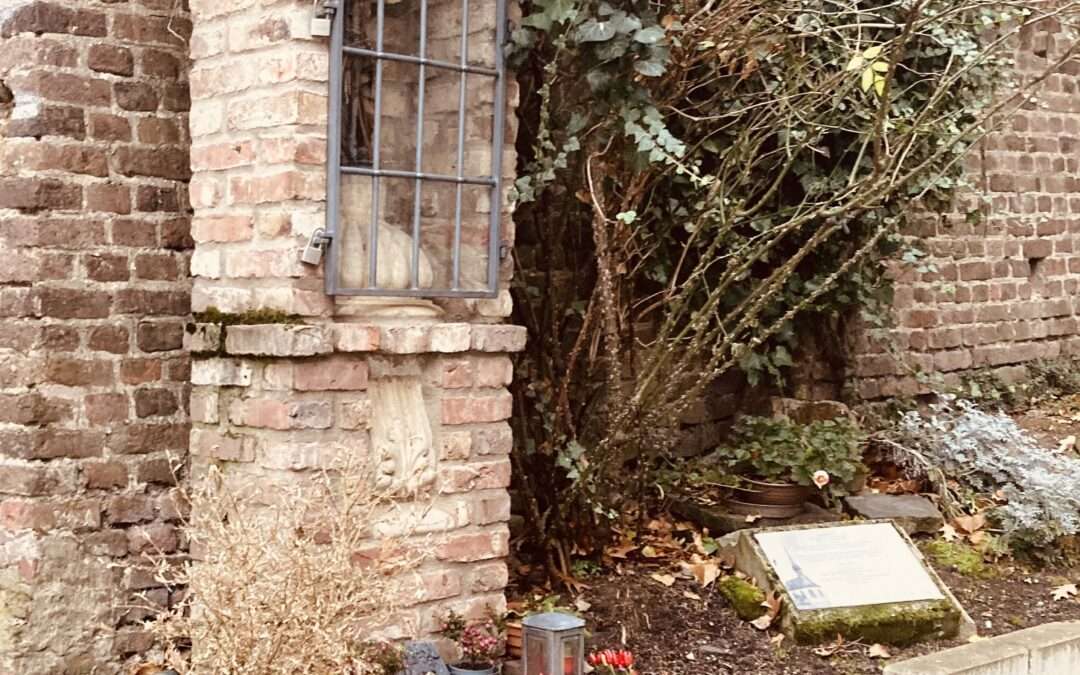
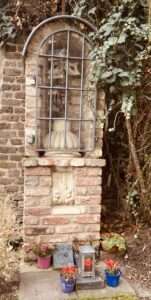
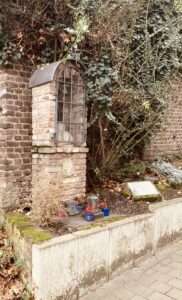 The chapel was dedicated to Saint Gertrude of Nivelles, who lived in the first half of the 7th century. As a patron saint, she had a very broad portfolio. She was invoked against plagues of rats and mice (hence the mice as her attribute), and was considered the protector of travellers, pilgrims and sailors, gardeners, spinners and even cats. In addition, her historically documented commitment to nursing and the education of girls and women is still remembered today.
The chapel was dedicated to Saint Gertrude of Nivelles, who lived in the first half of the 7th century. As a patron saint, she had a very broad portfolio. She was invoked against plagues of rats and mice (hence the mice as her attribute), and was considered the protector of travellers, pilgrims and sailors, gardeners, spinners and even cats. In addition, her historically documented commitment to nursing and the education of girls and women is still remembered today.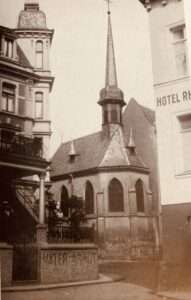 The building, which was destroyed in 1944, was not an architectural gem and no longer had any great spiritual significance. It was a simple single-nave hall building from the 15th century with modest furnishings. It was originally located directly behind the city wall next to the ‘Gierpforte’ whose name is derived from ‘Gertrud’. Even after the wall was demolished in the 19th century, there was no unobstructed view of the Rhine. A hotel building between the riverbank and the chapel ensured that the backyard situation remained unchanged. The parish church of the district was St. Remigius on what is now Remigiusplatz, with the Gertrudiskapelle chapel merely a branch. For a long time, its main users were the local boatmen and their brotherhood. This Cinderella existence may explain why there was hardly any opposition to the demolition of the little church.
The building, which was destroyed in 1944, was not an architectural gem and no longer had any great spiritual significance. It was a simple single-nave hall building from the 15th century with modest furnishings. It was originally located directly behind the city wall next to the ‘Gierpforte’ whose name is derived from ‘Gertrud’. Even after the wall was demolished in the 19th century, there was no unobstructed view of the Rhine. A hotel building between the riverbank and the chapel ensured that the backyard situation remained unchanged. The parish church of the district was St. Remigius on what is now Remigiusplatz, with the Gertrudiskapelle chapel merely a branch. For a long time, its main users were the local boatmen and their brotherhood. This Cinderella existence may explain why there was hardly any opposition to the demolition of the little church.
Recent Comments